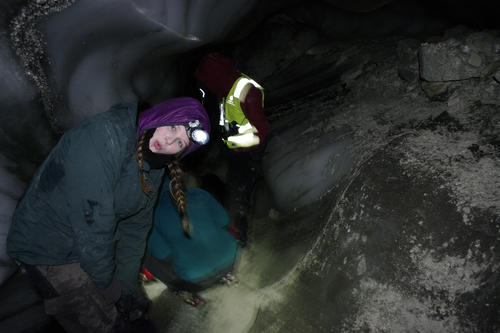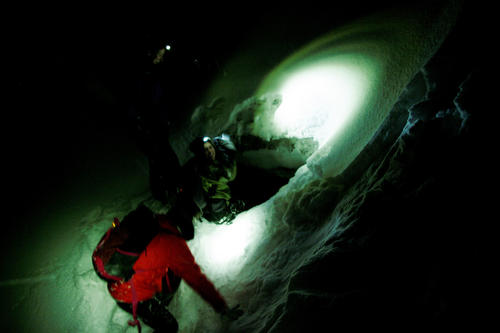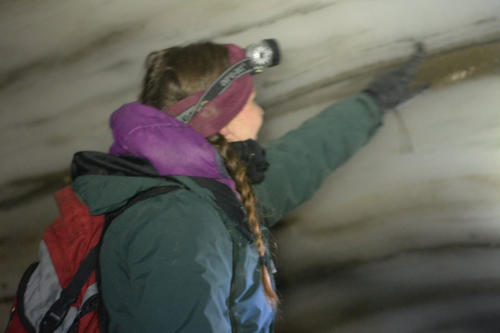“It feels like stepping inside a huge refrigerator”
Letter from Spitsbergen! Janna Einöder on her Arctic adventure in a glacier cave
Jan 25, 2016
“Cold, dark, and dirty” – Janna’s impression of the glacier cave.
Image Credit: Robynne Nowicki
The entrance to the glacier cave is not exactly reassuring.
Image Credit: Robynne Nowicki
Structures in the ice give a picture of the glacier’s history.
Image Credit: Alexandra Poje
As already reported, the polar night posed a challenge for us on numerous occasions. Apart from the darkness and a storm, the sense of being locked up in the valley also took a toll on us. In the summertime, we were able to make good use of our free days for excursions but during the dark winter days we regularly succumbed to cabin fever. This didn’t prevent us, however, from venturing out to discover the Arctic in the dark from time to time. One of this region’s highlights, namely glacier caves, still needed to be struck off our must-see list!
The glaciers, which are partially inaccessible during the summer months because of melt water channels, were completely frozen now. The melt water channels and the movement of the glaciers create underground caverns, so-called “ice caves,” that one can explore. Hiking through these caves is quite popular among tourists and some of the ice caves have been outfitted with rope ladders and stepping mats to make them more easily walkable. We, however, were looking for something a bit more adventurous and off the beaten tourist paths.
Equipped with a Headlamp and an Ice Pick
We thus got hold of a geologist who does research on glaciers at the university and knows her way around the subterranean network of ice paths quite well. And so we struck out on a dark December “day” to scout out a glacier cave that is not accessible to the public. This type of tour is not altogether without risks! Equipped with headlamps, ice picks and ropes, we braved our way through the driving snow to the snowed in entrance of the Longyearbreen Glacier Cave.
The entrance to this cave was a narrow gap in the ice-and-gravel mix at the edge of the glacier. A sheer endless path led down into the cave. With only the light from our headlamps, we slid into complete darkness. What an adventure! Deep in the cave we were suddenly in an entirely different world. We crawled through the narrow passageways past two-meter-long ice stalactites that hung from the ceiling and piles of gravel and stones in the larger sections of the cave.
A Brief Journey into the Past
In the glacier cave it felt kind of like being inside a big refrigerator; it was very cold and dark and there were no sounds or living organisms. It was exciting nonetheless because a glacier tells us of its own evolutionary history: Fossils evoke a time period billions of years ago when during the glacial period all life was covered in snow and ice. The structures and lines that can be discerned on the ceiling and walls reveal the glacier’s age or movement.
If, for example, there was more snowfall in a particular year, this will be reflected in the glacier’s white structures; dark, clear structures on the other hand indicate that there was a lot of ice that year. Based on such glaciers, researchers can figure out and interpret the atmosphere’s temperatures and CO2 concentrations as far back as 750,000 years ago! Our adventurous trip was thus also a journey into the past.



